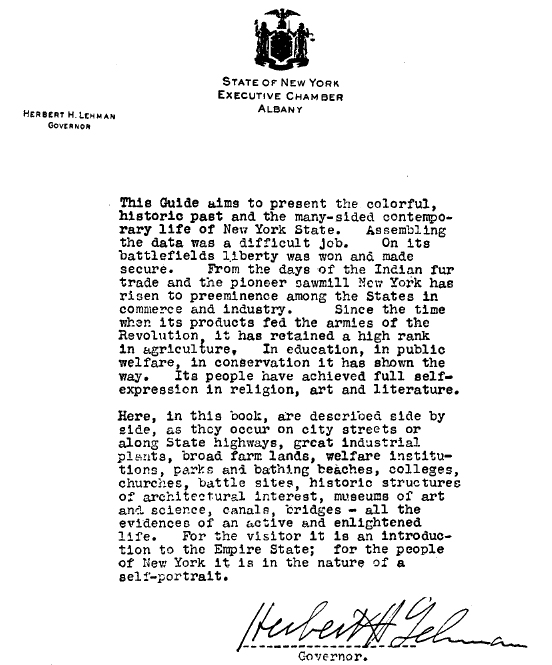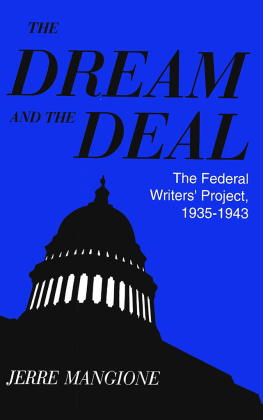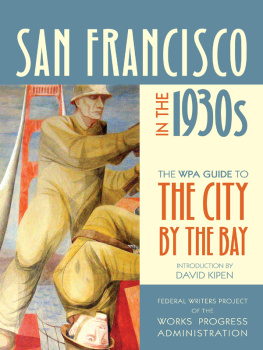NEW YORK
A Guide to the Empire State


Published in 2014 by Trinity University Press
San Antonio, Texas 78212
www.tupress.org
This book was first published as part of the Works Progress Administrations Federal Writers Project, a United States federal government project to fund written work and support writers during the Great Depression. It has been published in various editions, but this edition replicates the original. Trinity University Press is proud to make these books available through the WPA Guides to America Digital Library.
978-1-59534-230-0 ebook



T HIS book could hardly have been compiled without the co-operation of the community which is its subject. The contribution of the New York State Historical Association and of the Bureau of State Publicity is indicated on the title page. Dr. David M. Schneider, Director, and Albert Deutsch, Research Associate, of the Bureau of Research and Statistics, State Department of Social Welfare, contributed the chapter on Public Welfare. Dean Samuel N. Spring of the New York State College of Forestry at Syracuse University contributed an article on forestry; Mr. A.E. Champlin, Director of the New York State School of Agriculture at Cobleskill, contributed an article on agriculture. Other unnumbered State and local officials, and private citizens with public spirit, lent their aid.
Office space and equipment have been provided for Project workers by the Grosvenor Library, Buffalo; Sibley, Lindsay & Curr, Rochester; the Cayuga Museum of History and Art, Auburn; and by a number of cities, villages, and counties.
The drawings illustrating the chapter on Architecture are by Mr. T.C. Bannister. For the head and tail pieces the Writers Project is indebted to the skill of Mr. Harry Tedlie of the New York State Art Project.
My personal gratitude goes out to the several hundred men and women who had a hand in the preparation of this book. Many of them have found a place in private employment; several have established themselves as free-lance writers. They will all take pride in the achievement which this Guide represents. The human story behind the book they will keep in their memories.
With the exception of a few of the smaller towns and villages, the population figures used in the Guide were taken from the preliminary report of the 1940 Census.
BERTRAND M. WAINGER
Supervisor
August 1, 1940

Contents

Illustrations

Maps

Railroads: New York Central System; Erie R.R.; Delaware, Lackawanna & Western R.R. (D.L.& W.); Pennsylvania R.R. (Pennsy.); Long Island R.R.; Delaware & Hudson R.R. (D.& H.); New York, New Haven & Hartford R.R. (New Haven); Baltimore & Ohio R.R. (B.& O.); Boston & Maine R.R.; Rutland R.R.; Lehigh Valley R.R. (Lehigh); Central Railroad of New Jersey (Jersey Central); Staten Island Rapid Transit Ry.; Hudson & Manhattan R.R. (Hudson Tunnels).
Highways: 85,000 miles of highways, 51,000 miles paved; 547 numbered State highways, including 13 designated as Federal. Rigid State police patrol. Federal gas tax, 1; State gas tax 4; tax on oil absorbed by vendor.
Bus Lines: Adirondack Transit Lines, Arrow Bus Line, Blue Bus Line, Champlain Frontier Coach Lines, Greyhound Lines, Hoosic Valley Coach Lines, Hudson Transportation Lines, Interstate Bus Corporation, Martz Lines, Peter Pan Bus Line, Short Line, Vermont Transit Lines, Blue Way Trailways, DeCamp Bus Lines, Edwards Lakes to Sea Stages, Flying Eagle Whiteway Lines, Gray Line, Old Colony Coach Lines, Lincoln Transit Co., Manhattan Transit Co., New England Transportation Co., Pan American Bus Lines, Public Service Interstate Transportation Co., Safeway Trailways, Yelloway Busses, Boston & Maine Transit Co.; numerous short lines.
Air Lines: American Airlines Inc., daily service at Syracuse, Rochester, Buffalo, Binghamton (Johnson City), and New York City; Pennsylvania-Central Airlines, daily service at Buffalo; Airline Feeder System, Eastern Air Lines, Transcontinental & Western Air Inc., and United Air Lines, daily service at New York City; Pan American Airways, service at New York City (Port Washington, L.I.).
Boat Lines: Day line between New York and Albany (see Buffalo) and Lake Erie points, Detroit, and Chicago; coastwise and transoceanic service from New York City; lake steamer service on Lake George, Lake Placid, and Chautauqua Lake.
Ports of Entry: Buffalo, Dunkirk, Niagara Falls, Lewiston, New York, Albany, Rochester, Fair Haven, Oswego, Sodus Point, Syracuse, Chateaugay, Clayton, Fort Covington, Malone, Mooers, Morristown, Roosevelttown, Rouses Point, Waddington.
Citizens of the United States require no passports to enter Canada, but should be prepared to furnish evidence of identity. Foreign-born citizens and alien residents of the United States should carry credentials establishing legal residence.
Travelers permitted to import, duty-free and for personal use, merchandise to the value of $100 every 30 days. One gallon of alcoholic beverage may be brought in duty-free. Once every four months Canadians are allowed $100 in merchandise duty-free, provided they have been in the United States for a period of not less than 48 hours. Failure to report at the United States Customs entails a $100 fine for driver and car and $500 for each passenger.
Traffic Regulations: Reciprocity with other States is practiced with regard to operating licenses, except that a foreign license may not be used to drive for hire within the State.
No State speed limit, but speed in excess of 40 m.p.h. for m. is considered presumptive evidence of reckless driving. In special cases maximum speed is indicated on road signs. Incorporated villages and cities establish speed limits never less than 20 m.p.h.
Next page







